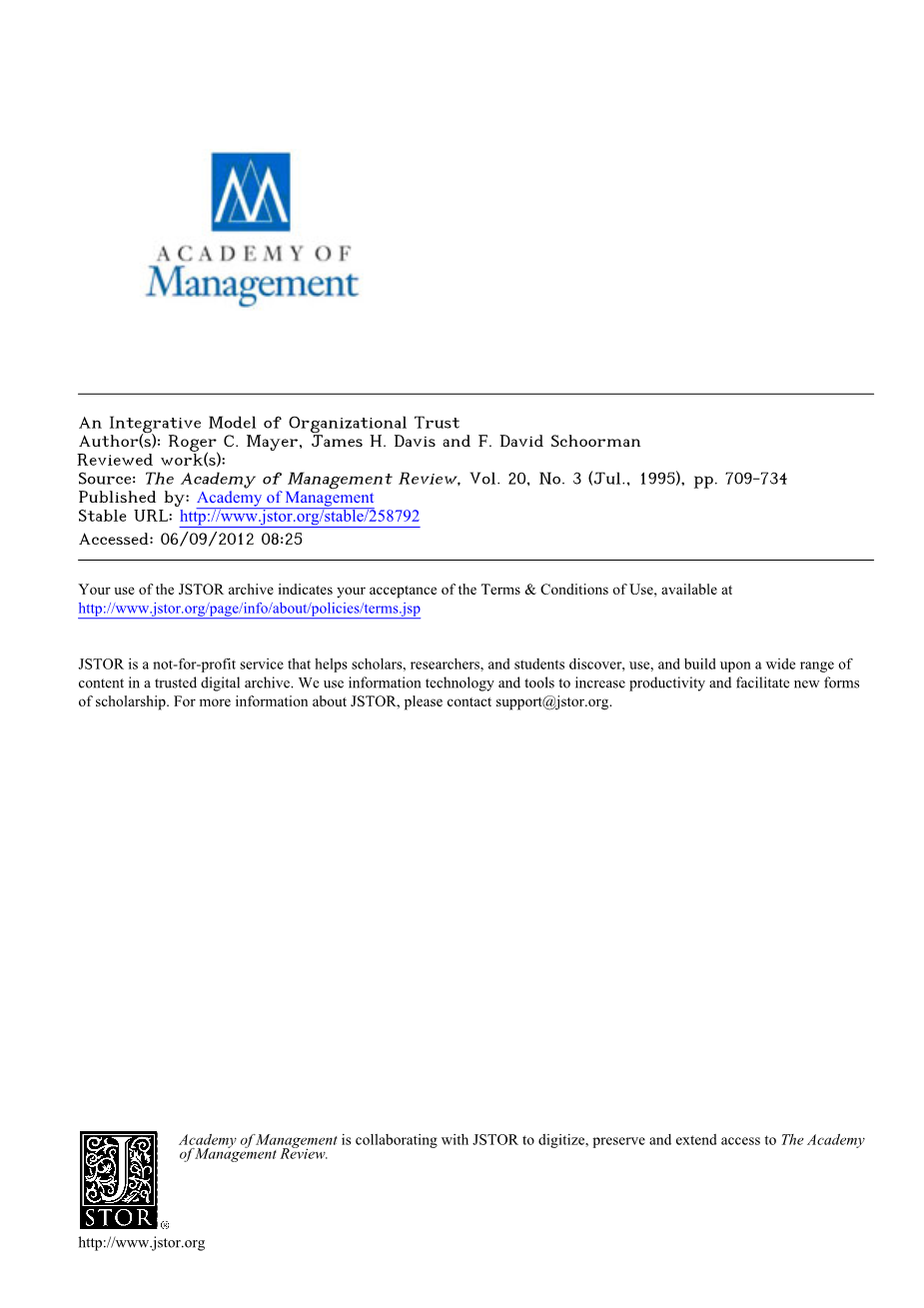

英语原文共 27 页,剩余内容已隐藏,支付完成后下载完整资料
组织信任的一个综合模型
结论与未来方向
本文提出了研究组织信任的若干问题。每一个问题都在组织环境二元模型的发展中被考虑和处理到了。本文提出的模型是第一个既明确考虑受信者特征又明确考虑信任者特征的模型。该模型清楚地区分了信任与促成信任的因素,也区分了信任与其在关系中承担风险的结果。目前的方法以一种不同于其他类似概念(合作、信心、可预测性)的方式定义信任,这些概念在文献中经常被与信任混淆。同样,风险的关键角色在这个模型中明确指定。这篇文章提出了一个通用的信任定义和一套简洁的决定因素。
导致信任的因素、信任本身和信任结果之间的差异是验证该模型的关键。为了全面测试模型,必须对这三个方面进行测量。对于受托人的能力、善行和正直的看法,必须使用与所提供的定义一致的衡量标准。以脆弱性和缺乏监控或控制能力为特征的行为可以评估以实施RTR。RTR必须以实际行为来衡量,而不是以参与行为的意愿来衡量。像监视这样的行为是在感情中缺乏冒险精神的例子。从度量的角度来处理这些行为,需要对其发生的度量进行反向评分。参与信任行为的感知风险程度应直接评估(如通过调查项目)或控制,如构建一个仿真模拟,其中受试者有有限的可能反应,且随他们他们所涉及的风险大小而明显不同。从度量的角度来看,模型中最成问题的部分是信任本身。因为信任是愿意变得脆弱的意愿,这是一种评估这种意愿被需要的方法。尽管从概念上看,信任与受信者的能力、善行和正直很容易区分,但将愿意脆弱与实际脆弱区分开来,就构成了一个更细微的区别。要衡量信任本身,需要一项调查或其他类似的方法,以了解某个人对受信者展现脆弱性的意愿,因为这与可观察到的RTR不同。
“你信任他们吗?”这个问题必须限定为:“信任他们做什么?”你信任他们的这个问题不仅取决于对他们正直和善良的评价,也取决于他们完成这些的能力。因此,如果一方在一个任务上被信任,即使在没有关于该方在新任务上能力的数据的情况下,是否会增加对另一个不相关任务的信任?与Sitkin和Roth(1993)的观点一致,该模型表明,能力评估可能不能在不同的任务或情况下一概而论。
应该承认该理论有几个局限性。首先,它的重点限于特定信任者对特定受信者的信任。因此,它对社会系统中理解信任的贡献(例如,Barber, 1983;Lewis amp; Weigert,1985)超出了这个模型的范围。第二,该模型中考虑的信任是单向的:从一个给定的信任者到一个给定的受信者。它目前的形式不是为了检验两方之间的相互信任的发展的。第三,该模型关注的是组织关系中的信任,其命题可能不能推广到其他环境中的关系。最后,这个模型中构造的标签是从先前研究信任的文献中使用的几个选项中选择的。对我们来说,这些标签最清楚地反映了提出的模型中定义的概念;但是,在某些情况下,这就使这些定义与以前对同一术语的某些使用有所不同。
除了模型特定的假设之外,还应该寻求其他一些研究途径。例如,信任的发展过程需要进一步的探索。我们提出对信任行为的需要会经常出现,但仍然缺乏关于这三个因素的数据。例如,员工可能没有与特定的经理进行足够的互动,无法评估经理对他或她的仁慈。为了收集这些数据,雇员首先可能必须展现出脆弱性(即信任经理),看看经理是如何对待这种脆弱性的。在这种情况下,员工可能不得不表现出一种类似于盲目信任的信任。取决于经理对这种脆弱性的反应,员工会建立起更多或更少的信任。
许多理论家认为,信任是在一系列观察和互动的基础上,随着时间的推移而演变的。考虑到我们的模型框架,一个关键问题是信任的演变过程。进一步的研究应该探究信任与合作的关系。博弈论学者倾向于将合作和信任等同起来,认为随着时间的推移,合作行为的模式会发展出信任(Axelrod,1984)。可以归因于外部动机的合作在多大程度上发展了信任?这一想法也表明,需要测试所提出的模型的反馈回路。
在组织研究的许多领域中,信任发挥着关键作用。本文所提出的模型的进一步发展和运作,将有助于组织的研究,从而加深对员工-组织联系、谈判和实施自我管理团队等主题的理解。AN INTEGRATIVE MODEL OF ORGANIZATIONAL TRUST
Conclusions and Future Directions
This article raises a number of issues for the study of trust in organizations. Each is considered and dealt with in the development of a model of dyadic trust in an organizational context. The model proposed in this article is the first that explicitly considers both characteristics of the trustee as well as the trustor. The model clearly differentiates trust from
factors that contribute to it, and it also differentiates trust from its outcome of risk taking in the relationship. The current approach defines trust in a way that distinguishes trust from other similar constructs (cooperation, confidence, predictability), which often have been confused with trust in the literature. Likewise, the critical role of risk is clearly specified in this model. This article develops a versatile definition of trust and a parsimonious set of determinants.
The differentiations between factors that cause trust, trust itself, and outcomes of trust are critical to the validation of this model. All three must be measured in order to fully test the model. Measures of the perceptions of a trustees ability, benevolence, and integrity must be developed that are consistent with the definitions provided. Behaviors that are characterized by vulnerability and the lack of ability to monitor or control can be assessed to operationalize RTR. RTR must be measured in terms of actual behavior, not willingness to engage in behavior. Such behaviors as monitoring are examples of a lack of risk taking in relationship. Dealing with these behaviors from a measurement perspective requires a reverse scoring of the measure of their occurrence. The extent of perceived risk involved in engaging in the trusting behavior should be assessed either directly (e.g., through survey items) or controlled for, such as structuring a simulation wherein the subjects have a limited number of possible responses that clearly vary in the amount of risk they involve. The most problematic component of the model from the standpoint of measurement is trust itself. Because trust is a willingness to be vulnerable, a measure that assesses that willingness is needed. Even though trust is conceptually easy to differentiate from perceived ability, benevolence, and integrity of the trustee, separating the willingness to be vulnerable from actually being vulnerable constitutes a finer distinction. To measure trust itself, a survey or other similar methodology that taps into the persons
willingness to be vulnerable to the trustee is needed, because this is distinct from observable RTR.
The question 'Do you trust them?' must be qualified: 'trust them to do what?' The issue on which you trust them depends not only on the assessment of integrity and benevolence, but also on the ability to accomplish it. Thus, if a party is trusted on one task, will that increase the trust on another unrelated task, even in the absence of data on the partys ability on the new task? Consistent with the arguments of Sitkin and Roth (1993), this model suggests that assessments of ability may not generalize across dissimilar tasks or situations.
Several limitations of the proposed theory should be recognized. First, its focus is limited to trust of a specific trustor for a specific trustee. Thus, its contribution to understanding trust in a social system (e.g., Barber, 1983; Lewis amp; Weigert, 1985) is beyond the scope of this model.
Second, trust as considered in this model is unidirectional: from a given trustor to a given trustee. In its present form it is not designed to examine the development of mutual trust between two parties. Third, this model is focused on trust in an organizational relationship, and its propositions may not generalize to relationships in
剩余内容已隐藏,支付完成后下载完整资料
资料编号:[258265],资料为PDF文档或Word文档,PDF文档可免费转换为Word
以上是毕业论文外文翻译,课题毕业论文、任务书、文献综述、开题报告、程序设计、图纸设计等资料可联系客服协助查找。
您可能感兴趣的文章
- 薪酬满意度作为工作满意度的先行因素:建立一个回归模型,确定公共和私人组织中薪酬满意度与工作满意度之间的线性关系外文翻译资料
- 胜任力与胜任力、胜任力模型与胜任力模型的比较研究外文翻译资料
- 如何提高企业网络招聘的有效性外文翻译资料
- 为初级职位招聘大学生,在制定战略和战术校园招聘计划时,需要考虑哪些问题?外文翻译资料
- 基于能力的招聘:招聘和留住成功员工的关键外文翻译资料
- 员工培训对体育门票销售人员工作满意度的影响外文翻译资料
- 由雇主参与的创新型员工激励模式外文翻译资料
- 浅析企业文化与企业绩效的相关性 ——以苏州金色未来信息咨询股份有限公司为例外文翻译资料
- 互联网背景下基于平衡计分卡的计算机绩效评价系统外文翻译资料
- 提高斯洛伐克公共行政部门招聘过程的效率外文翻译资料


